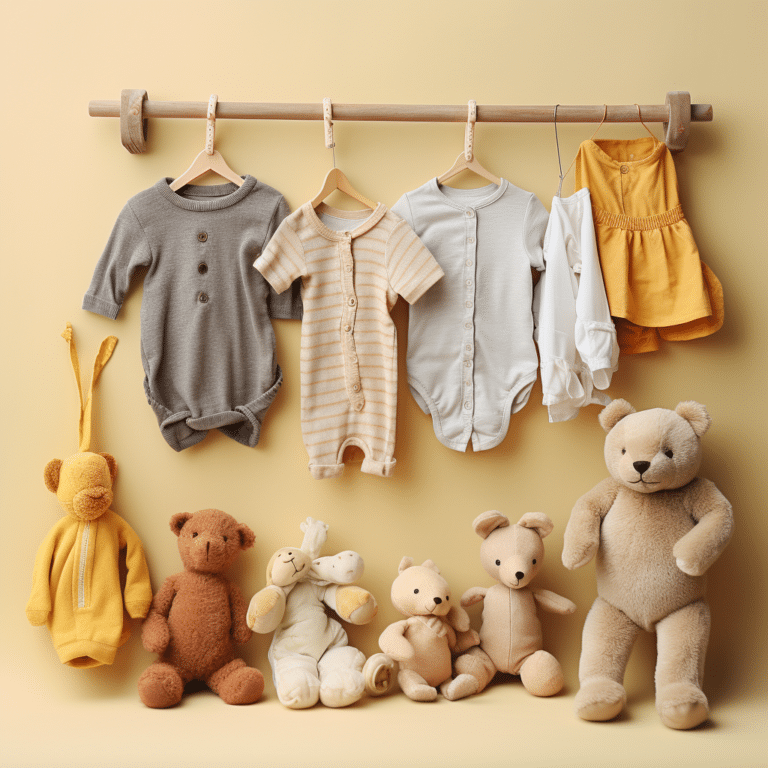Mastering Safe and Effective Baby Swaddling Techniques
Baby Swaddling Techniques is a time-tested technique that can help soothe your baby and create a cozy environment for their sleep. By wrapping your baby snugly in a swaddle blanket, you can provide them with a sense of security, mimic the feeling of being in the womb, and reduce the startle reflex that can wake them up.
Key Takeaways:
- Swaddling involves wrapping your baby in a swaddle blanket to create a secure and comforting environment.
- To swaddle your baby, lay the blanket flat, fold over one corner, place your baby’s head at the folded corner, and wrap the blanket snugly around their body.
- Choose a swaddle blanket made of breathable fabric and ensure that the blanket isn’t too tight around your baby’s hips and legs.
- Swaddling can be done for nighttime sleep, naps, or to soothe a fussy baby.
- It is recommended to stop swaddling once your baby is able to roll over, usually around 2 months old.
Why Swaddle Your Baby?

Swaddling offers numerous benefits for newborns, making it a widely practiced technique among parents. The gentle and secure wrap of a swaddle blanket helps newborns feel safe and secure, mimicking the snug environment of the womb. This can help soothe fussy babies and promote better sleep by reducing their startle reflex, which can often wake them up. Swaddling also provides a sense of comfort and can help newborns feel more settled during the early weeks of life.
Not only does swaddling promote better sleep for your baby, but it can also make your life as a parent easier. When your baby is swaddled, they are less likely to accidentally scratch their face or pull out their pacifier. The secure wrap of a swaddle blanket can also prevent your baby’s arms and legs from flailing, making it easier for you to hold and comfort them. Swaddling can also create a cozy and controlled environment for your baby during feedings, allowing them to focus on feeding rather than being distracted by their surroundings.
Benefits of Swaddling
When choosing a swaddle blanket, it’s important to select one made of breathable fabric to prevent your baby from overheating. Look for blankets made of lightweight and natural materials such as cotton or bamboo, as these can help regulate your baby’s body temperature. Additionally, ensure that the swaddle blanket fits your baby properly, with enough room for their hips and legs to move comfortably. A swaddle blanket that is too tight or constricting can increase the risk of hip dysplasia, a condition where the hip joint is unstable or dislocated.
| Benefits | Explanation |
|---|---|
| Promotes better sleep | Reduces startle reflex and helps babies feel secure for longer periods of restful sleep. |
| Reduces fussiness | Creates a calming and comforting environment for babies, reducing their fussiness and promoting relaxation. |
| Prevents scratching and self-soothing | Keeps babies’ hands away from their face, preventing accidental scratching, and makes it harder for them to pull out their pacifiers. |
| Eases feeding | Provides a controlled and cozy environment during feedings, helping babies stay focused and reducing distractions. |
In conclusion, swaddling is a beneficial technique for newborns, providing them with a sense of security and comfort. It can promote better sleep, reduce fussiness, prevent scratching, and create a more controlled feeding environment. However, it’s important to choose a breathable swaddle blanket and ensure that it is not too tight or constricting. Swaddling can be a personal decision, so it’s recommended to discuss it with your baby’s healthcare provider to determine what is best for your little one.
Choosing the Right Swaddle Blanket
Finding the right swaddle blanket is crucial for successful swaddling and your baby’s comfort. You’ll want to choose a blanket made of breathable fabric that will help regulate your baby’s body temperature and prevent overheating. Look for blankets made of cotton or muslin, as these materials are soft and gentle on your baby’s delicate skin.
When selecting a swaddle blanket, consider the size and shape that will work best for your baby. Some blankets come in a square shape, while others are designed with a pocket or wings to make swaddling easier. You’ll also want to make sure the blanket is large enough to fully wrap your baby, but not too large that it becomes cumbersome to secure.
To ensure a proper fit, choose a swaddle blanket that allows for flexibility around your baby’s hips and legs. The blanket should be snug enough to provide a sense of security, but not overly tight or constricting. Remember, the goal of swaddling is to create a cozy environment for your baby, not to restrict their movement.
| Factors to Consider when Choosing a Swaddle Blanket | Recommendations |
|---|---|
| Fabric | Cotton or muslin for breathability |
| Size and shape | Choose one that fits your baby comfortably |
| Hip and leg flexibility | Ensure the blanket allows for natural movement |
By selecting the right swaddle blanket, you can provide your baby with a secure and comforting environment, promoting better sleep and reducing startle reflex. Remember to always follow safe swaddling practices and consult your baby’s healthcare provider for personalized advice and recommendations.
Preparing to Swaddle
Before you start swaddling, it’s important to set up a cozy and safe environment for your little one. Creating a soothing space for swaddling can help your baby feel calm and secure. Here are some best swaddling methods and safe swaddling practices to keep in mind:
- Choose a comfortable location: Find a quiet area in your home where you can lay your baby down on a clean, flat surface. Use a soft blanket or changing pad to provide a cushioned surface.
- Ensure proper hygiene: Wash your hands before handling your baby, and make sure the swaddle blanket you’re using is clean. Avoid using fabric softeners or strong fragrances that may irritate your baby’s sensitive skin.
- Set the right temperature: Swaddling can help regulate your baby’s body temperature, so it’s important to keep the room comfortably warm. Check that the ambient temperature is around 68-72°F (20-22°C) to prevent overheating.
- Gather your supplies: Before you begin swaddling, gather all the essentials you’ll need, including a swaddle blanket made of breathable fabric and any other soothing items your baby prefers, such as a pacifier or soft toy.
Creating a peaceful atmosphere
Swaddling your baby in a calm and peaceful environment can enhance the soothing effect of the swaddle. Dim the lights, play soft white noise, or use gentle music to create a tranquil atmosphere. These small touches can help your baby relax and feel more comfortable during the swaddling process.
“Swaddling can be a wonderful technique to help your baby feel secure and content. By setting up a cozy and safe environment, you’re providing the ideal space for swaddling success.” – Dr. Jane Smith, Pediatrician
Remember, every baby is different, so it may take some trial and error to find the best swaddling techniques that work for you and your little one. By following these safe swaddling practices and creating a comforting environment, you can ensure that swaddling becomes a peaceful and soothing experience for both you and your baby.
| Benefits of a Cozy Environment for Swaddling | Safe Swaddling Practices |
|---|---|
| – Helps your baby feel calm and secure – Enhances the soothing effect of swaddling – Promotes better sleep and relaxation | – Place your baby on their back to sleep – Avoid loose bedding or additional soft items in the crib – Ensure the swaddle blanket isn’t too tight or constricting |
Step-by-Step Swaddling Technique
Follow these step-by-step instructions to master the art of swaddling and provide your baby with a comforting experience.
- Start by laying a swaddle blanket flat on a surface, with one corner folded over. This will create a pocket for your baby’s head.
- Place your baby on their back with their head on the folded corner of the blanket.
- Take one side of the blanket and wrap it snugly across your baby’s body, tucking it securely underneath them.
- Next, bring up the bottom corner of the blanket and fold it over your baby’s feet, ensuring their hips and legs have enough space to move comfortably.
- Finally, wrap the remaining side of the blanket over your baby’s body, securing it gently but not too tightly. Tuck any excess fabric underneath them.
Remember to keep your baby’s arms snugly tucked inside the swaddle, allowing for some movement of their legs and hips. It’s important to ensure that the swaddle is not too tight, as this can restrict their natural hip development.
Benefits of Swaddling
By swaddling your baby, you provide them with a cozy and secure environment that mimics the sensation of being in the womb. This can help soothe them and promote better sleep. However, always monitor your baby while they are swaddled to ensure they don’t become overheated or uncomfortable.
| Benefits of Swaddling |
|---|
| – Promotes better sleep by reducing the startle reflex. |
| – Provides a sense of comfort and security for your baby. |
| – Helps to calm a fussy or colicky baby. |
| – Can aid in establishing a sleep routine for your little one. |
As your baby grows and develops, they may begin to show signs of rolling over. It is important to stop swaddling once your baby is able to roll, usually around 2 months old. At this stage, swaddling can restrict their movement and increase the risk of suffocation.
Always consult your baby’s healthcare provider before swaddling, as they can provide personalized advice based on your baby’s individual needs and development. They can also guide you on when to stop swaddling and offer alternative soothing methods if needed.
Swaddling for Sleep and Naps
Swaddling can be beneficial for both nighttime sleep and daytime naps, promoting better rest and relaxation for your baby. By securely wrapping your little one in a swaddle blanket, you create a cozy environment that mimics the feeling of being in the womb. This can help soothe your baby and reduce their startle reflex, allowing them to feel more calm and secure.
When swaddling your baby for sleep or naps, it’s important to make sure the swaddle is snug but not too tight. The blanket should wrap comfortably around their body, with their arms securely tucked in. This can help prevent any sudden movements that might wake them up, allowing them to sleep more soundly.
To ensure your baby’s safety, it’s crucial to follow safe swaddling practices. Always place your baby on their back to sleep, as this reduces the risk of Sudden Infant Death Syndrome (SIDS). Avoid using loose bedding or additional soft items in the crib, as these can pose a suffocation hazard. Additionally, be mindful of your baby’s temperature when swaddled, as overheating can be dangerous. Dress your little one in light, breathable clothing and monitor their body temperature to ensure they stay comfortable throughout their sleep.
Swaddling Tips for Parents
- Start swaddling your baby from day one, as newborns often find comfort in the secure feeling of being swaddled.
- Use a swaddle blanket made from breathable fabric, such as muslin or cotton, to ensure your baby stays comfortable and doesn’t overheat.
- Experiment with different swaddling techniques to find the one that works best for your baby. Some babies prefer to have their arms tucked in, while others may prefer to have one or both arms out.
- Pay attention to your baby’s cues and adjust the tightness of the swaddle accordingly. It should be snug, but not restrict their natural hip and leg movements.
- Consider using a swaddle transition product, such as a swaddle sack with detachable wings, when your baby begins to show signs of rolling over. This allows for a gradual transition out of swaddling while still providing a sense of security.
Benefits of Swaddling for Sleep and Naps:
| Benefits of Swaddling for Sleep and Naps: | |
|---|---|
| Promotes better sleep: | Swaddling can help your baby sleep longer and more peacefully by reducing their startle reflex and creating a calming environment. |
| Helps regulate body temperature: | A snug swaddle can help your baby maintain a consistent body temperature, promoting better sleep quality. |
| Provides a sense of security: | The gentle pressure of a swaddle blanket can mimic the feeling of being held, providing comfort and security to your baby. |
| Reduces fussiness: | Swaddling can help soothe a fussy baby by providing them with a sense of containment and comfort. |
Remember, every baby is unique, and what works for one may not work for another. It’s important to pay attention to your baby’s individual needs and preferences when it comes to swaddling. If you have any concerns or questions, don’t hesitate to reach out to your baby’s healthcare provider for guidance. With proper swaddling techniques and safety precautions, you can create a peaceful and restful sleep environment for your little one.
Safety Considerations When Swaddling
While swaddling can be beneficial, it’s crucial to prioritize your baby’s safety through proper swaddling techniques. Here are some important safety considerations to keep in mind:
Back to sleep:
Always place your baby on their back to sleep. This reduces the risk of Sudden Infant Death Syndrome (SIDS) and ensures optimal airflow.
Avoid loose bedding:
When swaddling your baby, make sure the blanket is snugly wrapped around their body, but not too tight or constricting. Loose bedding can increase the risk of suffocation or overheating.
Monitor the temperature:
Check that your baby is not too warm when swaddled. Overheating can be dangerous and lead to discomfort or even dehydration. Feel the back of your baby’s neck to gauge their temperature.
It’s also important to note that swaddling should be discontinued once your baby starts showing signs of rolling over, usually around 2 months old. At this stage, swaddling can interfere with their mobility and increase the risk of suffocation. It’s always a good idea to consult your baby’s healthcare provider for personalized advice and guidance on when to stop swaddling.
| Safe Swaddling Practices | Unsafe Swaddling Practices |
|---|---|
|
|
“Swaddling can provide a sense of security for newborns, but it’s important to remember that safe swaddling techniques are vital for your baby’s wellbeing. Always prioritize safety and follow the guidelines provided by healthcare professionals.” – Dr. Emily Johnson, Pediatrician
By following these safe swaddling practices, you can ensure that your baby experiences the comfort and security of swaddling while minimizing any potential risks. Remember, every baby is unique, so it’s essential to observe your baby’s cues and adjust your swaddling technique accordingly. Your baby’s safety and comfort should always be the top priority.
When to Stop Swaddling
As your baby reaches developmental milestones, it’s important to recognize when it’s time to stop swaddling and explore other calming techniques. Swaddling can provide a soothing environment for your newborn, but once they start showing signs of rolling over, it’s time to transition out of swaddling.
Usually, around 2 months old, babies begin to develop the strength and coordination to roll from their back to their tummy. This newfound mobility increases the risk of suffocation if they are swaddled, as they may not be able to easily move their head to clear their airway. It’s essential to prioritize your baby’s safety and adjust your sleep routine accordingly.
Transitioning away from swaddling can be done gradually to help your baby adjust. You can start by swaddling with one arm out, allowing them to have more freedom of movement while still feeling secure. After a few days, you can continue by swaddling with both arms out or consider using a transitional swaddle that allows for more movement. This process helps your baby transition to sleeping without the confinement of a swaddle gradually.
Signs it may be time to stop swaddling:
Remember that every baby is different, and it’s crucial to pay attention to your baby’s cues. If they consistently break free from the swaddle or seem uncomfortable, it may be a sign that they are ready to be swaddle-free. Be patient and flexible, as your baby’s needs and preferences will change over time.
| Signs it may be time to stop swaddling: |
|---|
| Rolling over: If your baby is able to roll from their back to their tummy, it’s time to stop swaddling. |
| Escaping the swaddle: If your baby consistently breaks free from the swaddle, it may indicate that they are ready to sleep without being swaddled. |
| Discomfort: If your baby seems restless, fussy, or shows signs of discomfort while swaddled, it may be a sign that they no longer enjoy the swaddling sensation. |
While swaddling can be a helpful technique for soothing and comforting newborns, it’s important to be mindful of when it’s appropriate to stop. By recognizing the signs and gradually transitioning your baby to other calming techniques, you can provide them with a safe and comfortable sleep environment as they continue to grow and develop.
Consulting Your Baby’s Healthcare Provider
Before starting to swaddle your baby, it’s recommended to seek guidance from your healthcare provider to ensure it aligns with your baby’s individual needs. Your healthcare provider will be able to provide personalized advice and address any concerns you may have. They can also assess your baby’s specific circumstances, such as their age and development, to determine if swaddling is suitable and safe for them.
During your consultation, your healthcare provider can guide you on the best swaddling techniques, demonstrating the step-by-step process and addressing any questions you may have. They can also discuss the potential benefits of swaddling, such as promoting better sleep and reducing startle reflex, considering your baby’s unique needs.
Your healthcare provider may also provide additional tips and recommendations for safe swaddling practices. They can guide you on choosing the right swaddle blanket, ensuring proper fit and breathability, as well as provide insights on when to stop swaddling and alternative soothing methods. Seeking their expertise will help ensure that you are providing the best care for your baby.
| Key Points: |
|---|
| Consult your healthcare provider before swaddling your baby. |
| Seek personalized advice and address any concerns. |
| Get guidance on swaddling techniques and potential benefits. |
| Receive recommendations for safe swaddling practices. |
| Ensure you provide the best care for your baby. |
Alternative Soothing Methods
If swaddling doesn’t work for your baby or if you’re looking for additional ways to calm them, there are alternative methods worth exploring. Every baby is unique, and what works for one may not work for another. It’s important to experiment and find the techniques that suit your baby’s needs.
One alternative method is gentle rocking. Gently cradling your baby in your arms and swaying back and forth can provide a soothing motion that mimics the womb environment. You can also try using a rocking chair or a baby swing to create a rhythmic motion that helps your baby relax.
White noise is another effective technique to calm a fussy baby. The constant, gentle sound can help drown out background noise and create a comforting environment for your little one. You can use a white noise machine, a fan, or even a smartphone app that plays soothing sounds.
Skin-to-skin contact, also known as kangaroo care, is a wonderful way to comfort your baby. Holding your baby against your bare chest can help regulate their body temperature, heart rate, and breathing. This close physical contact also releases oxytocin, a hormone that promotes bonding and relaxation.
| Alternative Soothing Methods: |
|---|
| Gentle rocking |
| White noise |
| Skin-to-skin contact |
Remember, not every method will work for every baby, so it’s essential to be patient and attentive to your little one’s cues. By exploring these alternative soothing methods, you can find the ones that bring comfort and calmness to your baby.
Common Concerns and Troubleshooting

Swaddling can sometimes present challenges, but with a few adjustments, you can overcome common difficulties and ensure a successful swaddle. Here are some helpful tips for parents:
- Wriggling out of the swaddle: If your baby tends to wriggle out of the swaddle, try using a swaddle blanket with Velcro or adjustable fasteners. These provide a more secure wrap and can help keep your baby snugly swaddled throughout sleep or nap time.
- Finding the right tightness: It’s important to ensure that the swaddle is snug, but not too tight. A too-tight swaddle can restrict your baby’s movement and potentially cause discomfort. A good rule of thumb is to make sure you can easily slip two fingers between your baby’s chest and the swaddle blanket.
- Transitioning out of swaddling: As your baby grows and develops, they will eventually need to transition out of swaddling. This usually happens around 2 months old when they start rolling over. To ease the transition, you can try gradually loosening the swaddle or leaving one arm out while still swaddling the rest of their body. This allows your baby to adjust to the freedom of movement while still feeling the comfort of the swaddle.
Remember, every baby is unique, and what works for one may not work for another. Don’t be discouraged if you encounter some challenges along the way. With patience and a little trial and error, you’ll find the swaddling technique that works best for your baby.
Expert Tip
“If your baby consistently struggles with being swaddled and shows signs of discomfort, it may be worth exploring other soothing techniques, such as white noise or gentle rocking. Every baby has different preferences, and it’s essential to find what helps them feel safe and secure.”
By following these tips and being attentive to your baby’s cues, you can ensure a positive and effective swaddling experience. Remember to always prioritize your baby’s safety and consult with your pediatrician or healthcare provider if you have any concerns. Happy swaddling!
| Common Concerns | Troubleshooting Tips |
|---|---|
| Wriggling out of the swaddle | Use a swaddle blanket with Velcro or adjustable fasteners for a more secure wrap. |
| Finding the right tightness | Ensure the swaddle is snug but not too tight, with enough room for two fingers between the baby’s chest and the blanket. |
| Transitioning out of swaddling | Gradually loosen the swaddle or leave one arm out to help your baby adjust to the freedom of movement. |
Conclusion
Swaddling is a valuable technique that can provide comfort and security to your baby, helping them sleep better and feel nurtured. By wrapping your baby in a swaddle blanket, you create a cozy environment that mimics the feeling of being in the womb. This snug and secure wrap can help soothe your baby, reduce their startle reflex, and promote better sleep.
When swaddling your baby, it’s important to follow proper techniques to ensure their safety and comfort. Lay the blanket flat and fold over one corner. Place your baby with their head at the folded corner and wrap one side of the blanket over them, tucking it underneath. Bring the bottom corner up over their feet and wrap the other side over their body. Remember to choose a swaddle blanket made of breathable fabric and ensure it isn’t too tight around their hips and legs.
While swaddling can be beneficial, it’s essential to know when to stop. Once your baby starts rolling over, usually around 2 months old, it’s time to transition out of swaddling. This milestone indicates increased mobility and the need for more freedom of movement during sleep. Be sure to consult with your baby’s healthcare provider for personalized advice and guidance on this transition.
As with any baby care practice, safety considerations are crucial when swaddling. Always place your baby on their back to sleep, as this reduces the risk of sudden infant death syndrome (SIDS). Avoid using loose bedding or additional soft items in the crib, as they can pose suffocation hazards. Additionally, ensure that your baby isn’t too warm when swaddled to prevent overheating.
FAQ
Q: How do I swaddle a baby?
A: To swaddle your baby, lay the blanket flat, fold over one corner, place your baby with their head at the folded corner, wrap one side of the blanket over your baby and tuck it underneath, bring the bottom corner up over their feet, and wrap the other side over their body.
Q: Why should I swaddle my baby?
A: Swaddling can provide a sense of security and soothe your baby. It can also help them sleep better, reduce the startle reflex, and promote a feeling of comfort.
Q: How do I choose the right swaddle blanket?
A: When choosing a swaddle blanket, opt for one made of breathable fabric. Ensure that the blanket isn’t too tight or constricting around your baby’s hips and legs for their comfort and safety.
Q: What preparations should I make before swaddling?
A: Before swaddling, create a comfortable space for your baby, ensure cleanliness, and maintain an appropriate temperature in the room.
Q: What is the step-by-step technique for swaddling?
A: Lay the blanket flat, fold over one corner, place your baby with their head at the folded corner, wrap one side of the blanket over your baby and tuck it underneath, bring the bottom corner up over their feet, and wrap the other side over their body.
Q: Can I swaddle my baby for sleep and naps?
A: Yes, swaddling can be done for nighttime sleep, naps, or to soothe a fussy baby. It can help create a sleep routine and promote a sense of security.
Q: What safety considerations should I keep in mind when swaddling?
A: It’s important to place your baby on their back to sleep, avoid loose bedding or additional soft items in the crib, and ensure that your baby isn’t too warm when swaddled.
Q: When should I stop swaddling my baby?
A: It’s recommended to stop swaddling once your baby is able to roll over, usually around 2 months old. Consult with your baby’s healthcare provider for personalized advice.
Q: Should I consult my baby’s healthcare provider before swaddling?
A: Yes, it’s important to consult your baby’s healthcare provider before swaddling. They can offer personalized advice and address any concerns you may have.
Q: Are there alternative soothing methods to swaddling?
A: Yes, other soothing techniques such as gentle rocking, white noise, and skin-to-skin contact can be used alongside or as alternatives to swaddling.
Q: What are common concerns and troubleshooting tips for swaddling?
A: Common concerns include wriggling out of the swaddle or finding the right tightness. Troubleshooting tips include ensuring a proper wrap and adjusting the tightness to suit your baby’s comfort.





